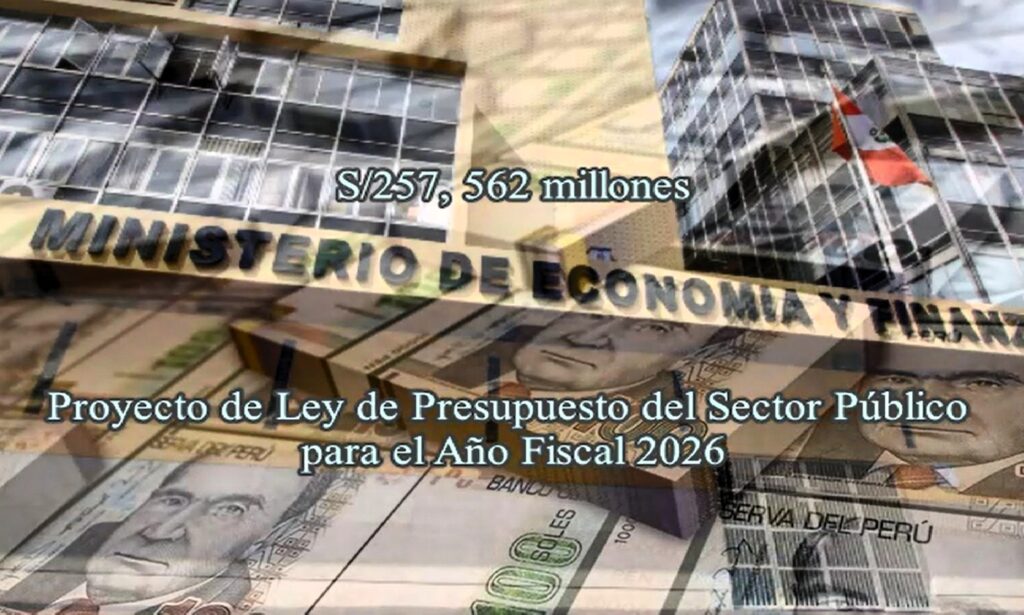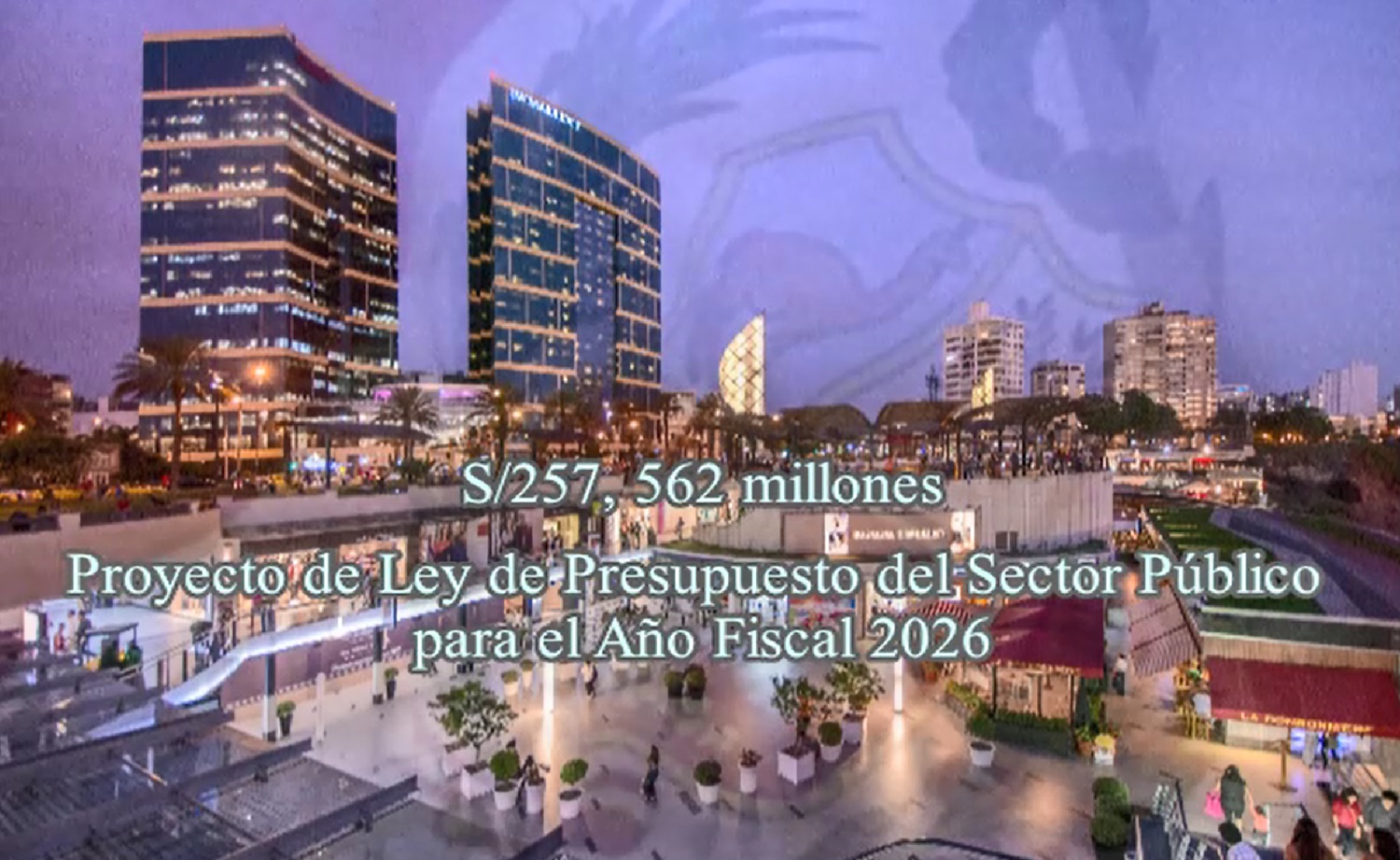Agencia Peruana de Noticias PRENSAPERU.PE https://prensaperu.pe/ Twitter: @prensaperupe El Ministerio de Economía y Finanzas (MEF) ha anunciado la aprobación unánime por el Consejo de Ministros del Proyecto de Ley de Presupuesto del Sector Público para el Año Fiscal 2026, ascendiendo a S/257 562 millones. Este monto representa un incremento del 2.2 % en comparación con el presupuesto institucional de apertura de 2025, y se complementa con la aprobación de los proyectos de Ley de Equilibrio Financiero y de Endeudamiento.
DIÁLOGO INTERINSTITUCIONAL Y PRIORIDADES SECTORIALES.
El MEF ha llevado a cabo un extenso proceso de consulta con gobiernos regionales y ministerios clave (Energía y Minas, Salud, Educación, Transportes y Comunicaciones, Vivienda, Trabajo, entre otros). Este diálogo estratégico ha permitido alinear el Proyecto de Presupuesto 2026 con las necesidades territoriales y sectoriales más apremiantes, garantizando una asignación eficiente de recursos y una mejora en la calidad de vida de los ciudadanos.
CRITERIOS DE DISEÑO PRESUPUESTARIO: DESCENTRALIZACIÓN Y SOSTENIBILIDAD FISCAL
El Proyecto de Presupuesto 2026 se ha estructurado bajo los principios de descentralización y sostenibilidad fiscal, con una meta de déficit del 1.8 % del PBI. Se prioriza la asignación directa de recursos a gobiernos regionales y locales, disminuyendo la dependencia de transferencias adicionales durante la ejecución. En este contexto, el presupuesto de los gobiernos regionales experimenta un aumento del 8.6 %, mientras que el de los gobiernos locales, impulsado por el incremento del FONCOMUN según la Ley N.º 32387, crece un 3.0 %. Se asegura la continuidad de las inversiones en los tres niveles de gobierno, así como los incrementos salariales ya establecidos por ley.
ASIGNACIÓN SECTORIAL ESTRATÉGICA
Más del 50 % del presupuesto se concentra en funciones esenciales como educación, salud, transporte, previsión social, orden público y seguridad.
Educación.
Se destinan S/ 19 658 millones para remuneraciones docentes y S/ 423 millones para la finalización del Proyecto Escuelas Bicentenario.
Salud.
Se asignan S/ 2 229 millones para el mejoramiento de hospitales y S/ 2 535 millones para asegurar la continuidad del aseguramiento universal.
Transporte.
Se destacan S/ 2 695 millones para la ejecución de las Líneas 1 y 2 del Metro de Lima y Callao, el inicio de las Líneas 3 y 4, y el Ferrocarril Lima–Ica.
Seguridad Ciudadana.
Se asignan S/ 5 140 millones para intervenciones policiales y S/ 1 009 millones para investigación y equipamiento criminalístico.
DECLARACIONES DEL MINISTRO DE ECONOMÍA Y FINANZAS
El ministro de Economía y Finanzas, Raúl Pérez-Reyes Espejo, enfatizó que “El Presupuesto 2026 es una herramienta que refleja la visión de un Estado moderno y responsable: descentralizado, con prioridades claras y enfocado en cerrar brechas sociales y de infraestructura. Cada sol invertido estará orientado a garantizar más y mejores servicios para la ciudadanía, con énfasis en salud, educación y seguridad”.
De otro lado demos señalar, que en el intrincado laberinto de la gestión fiscal, el Estado se erige como un equilibrista, caminando sobre la cuerda floja de las finanzas públicas. Tres pilares fundamentales sostienen su andar: la Ley de Presupuesto, la Ley de Equilibrio Fiscal y la Ley de Endeudamiento Público. Cada una, con su propia lógica y alcance, define los límites y las posibilidades de la acción gubernamental en el ámbito económico.
La Ley de Presupuesto, es el mapa que guía el gasto público. Cada año, el Parlamento, cual cartógrafo moderno, delinea las coordenadas financieras que marcarán el destino de los recursos del Estado. Se asignan fondos a salud, educación, infraestructura, defensa y un sinnúmero de otras áreas, en un ejercicio de priorización que refleja las políticas y los objetivos del gobierno de turno. Sin embargo, este mapa no es inmutable. A lo largo del año, tormentas imprevistas, como crisis económicas o desastres naturales, pueden obligar a recalcular la ruta, exigiendo ajustes y reasignaciones para mantener el rumbo.
La Ley de Equilibrio Fiscal, por su parte, es el cinturón de seguridad que evita caídas estrepitosas. Establece límites al déficit fiscal, obligando al Estado a mantener un balance entre ingresos y gastos. No se trata de una camisa de fuerza que asfixia la inversión pública, sino de un mecanismo prudente que garantiza la sostenibilidad de las finanzas a largo plazo. Como un navegante experimentado, el Estado debe anticipar las mareas y ajustar las velas para evitar naufragios.
La Ley de Endeudamiento Público, es la que define las reglas del juego en el mercado de capitales. El Estado, como cualquier agente económico, puede recurrir al crédito para financiar proyectos de inversión o cubrir déficits temporales. Sin embargo, esta herramienta debe utilizarse con responsabilidad, evitando caer en la espiral de la deuda insostenible. Como un escalador experto, el Estado debe medir cada paso, asegurándose de que la cuerda sea lo suficientemente resistente para soportar el peso de sus ambiciones.
CONCLUSIÓN
Con este paso, el Gobierno reafirma su compromiso con una gestión fiscal prudente y con el desarrollo sostenible del país, promoviendo la competitividad y el bienestar ciudadano.
Fuente: Agencia Peruana de Noticias PRENSAPERU.PE https://prensaperu.pe/ Twitter: @prensaperupe

English Translation
Budget, Fiscal Balance and Public Debt Laws 2026. S/257,562 million, “The triangle of macroeconomic stability in Peru.”
Peruvian News Agency PRENSAPERU.PE https://prensaperu.pe/ Twitter: @prensaperupe The Ministry of Economy and Finance (MEF) has announced the unanimous approval by the Council of Ministers of the Public Sector Budget Bill for Fiscal Year 2026, amounting to S/257,562 million. This amount represents a 2.2% increase compared to the 2025 institutional opening budget and is complemented by the approval of the Financial Balance and Public Debt Bills.
INTERINSTITUTIONAL DIALOGUE AND SECTORAL PRIORITIES
The Ministry of Economy and Finance (MEF) has conducted an extensive consultation process with regional governments and key ministries (Energy and Mining, Health, Education, Transport and Communications, Housing, Labor, among others). This strategic dialogue has made it possible to align the 2026 Budget Project with the most pressing territorial and sectoral needs, ensuring efficient resource allocation and an improvement in citizens’ quality of life.
BUDGET DESIGN CRITERIA: DECENTRALIZATION AND FISCAL SUSTAINABILITY
The 2026 Budget Project has been structured under the principles of decentralization and fiscal sustainability, with a deficit target of 1.8% of GDP. Priority is given to the direct allocation of resources to regional and local governments, reducing dependence on additional transfers during execution. In this context, the regional government budget has increased by 8.6%, while the local government budget, driven by the increase in the FONCOMUN (Common Fund) under Law No. 32387, has grown by 3.0%. The continuity of investments at all three levels of government is ensured, as are the salary increases already established by law.
STRATEGIC SECTORAL ALLOCATION
More than 50% of the budget is concentrated on essential functions such as education, health, transportation, social security, public order, and security.
Education.
S/ 19,658 million are allocated for teacher salaries and S/ 423 million for the completion of the Bicentennial Schools Project.
Health.
S/ 2.229 billion is allocated for hospital improvements and S/ 2.535 billion to ensure the continuity of universal health insurance.
Transportation.
S/ 2.695 billion is allocated for the construction of Lines 1 and 2 of the Lima and Callao Metro, the start of Lines 3 and 4, and the Lima–Ica Railway.
Citizen Security.
S/ 5.140 billion is allocated for police interventions and S/ 1.009 billion for criminal investigation and equipment.
STATEMENTS BY THE MINISTER OF ECONOMY AND FINANCE
The Minister of Economy and Finance, Raúl Pérez-Reyes Espejo, emphasized that “The 2026 Budget is a tool that reflects the vision of a modern and responsible State: decentralized, with clear priorities, and focused on closing social and infrastructure gaps. Every sol invested will be used to guarantee more and better services for citizens, with an emphasis on health, education, and security.”
On the other hand, we must point out that in the intricate labyrinth of fiscal management, the State stands as a tightrope walker, walking the tightrope of public finances. Three fundamental pillars support its progress: the Budget Law, the Fiscal Balance Law, and the Public Debt Law. Each, with its own logic and scope, defines the limits and possibilities of government action in the economic sphere.
The Budget Law is the map that guides public spending. Each year, Parliament, like a modern cartographer, delineates the financial coordinates that will determine the allocation of state resources. Funds are allocated to health, education, infrastructure, defense, and countless other areas in a prioritization exercise that reflects the policies and objectives of the current government. However, this map is not immutable. Throughout the year, unforeseen storms, such as economic crises or natural disasters, may force a recalculation of the route, requiring adjustments and reallocations to stay on course.
The Fiscal Balance Law, for its part, is the safety belt that prevents precipitous declines. It sets limits on the fiscal deficit, requiring the State to maintain a balance between revenue and expenditure. It is not a straitjacket that stifles public investment, but a prudent mechanism that guarantees the long-term sustainability of finances. Like an experienced navigator, the State must anticipate the tides and adjust its sails to avoid shipwrecks.
The Public Debt Law defines the rules of the game in the capital market. The State, like any economic agent, can resort to credit to finance investment projects or cover temporary deficits. However, this tool must be used responsibly, avoiding falling into the spiral of unsustainable debt. Like an expert climber, the State must measure each step, ensuring that the rope is strong enough to support the weight of its ambitions.
CONCLUSIÓN
With this step, the Government reaffirms its commitment to prudent fiscal management and the country’s sustainable development, promoting competitiveness and citizen well-being.
Source: Peruvian News Agency PRENSAPERU.PE https://prensaperu.pe/ Twitter: @prensaperupe
